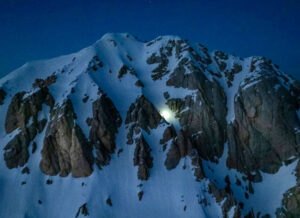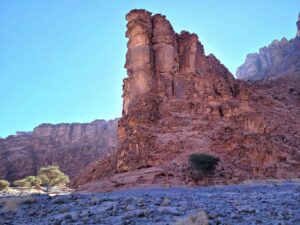Given the inherent subjectivity of peakbagging, it’s not surprising that Eric Gilbertson’s latest achievement is a bit difficult to describe.
The 34-year-old American has summited nearly 2,000 mountains worldwide, according to his own count on PeakBagger.com. But on Sept. 1, Gilbertson and his partner Andreas Frydensberg claimed a possible new first in mountaineering: climbing in all seven of “the ‘Stans.”
Put simply, the pair have climbed the highest mountain in seven countries in Central Asia: Afghanistan, Pakistan, Kyrgyzstan, Kazakhstan, Tajikistan, Uzbekistan, and Turkmenistan.
While that means Gilbertson and Frydensberg climbed the infamously dangerous K2 — Pakistan’s highest point — most of the other mountains aren’t well-known, even among mountaineers. Completing these seven high points is likely more difficult than summiting all 14 of the world’s peaks over 8,000m, said Gilbertson, who has summited three of them, in addition to an Everest attempt.
“This subset just kinda collects most of the hardest peaks in the world,” he told ExplorerWeb on Monday. “It’s a unique list because it’s so difficult. I’m not aware of other people who are collecting all these peaks.”
As for claiming the first ascent of all seven — Gilbertson has the evidence to back it up. Since 2018, he has been measuring mountains around the world to find the true high points. His research has resulted in new “highest mountains” for seven countries, including Uzbekistan, which he and Frydensberg summited in August.
According to his measurements, it’s Alpomish — not Khazret Sultan — that’s actually Uzbekistan’s high point.
“A lot of the time, just getting to base camp is one of the most difficult parts,” Gilbertson said of his far-flung ascents. “Sometimes, that feels like the crux.”

Gilbertson and Frydensberg on the summit of Alpomish. Photo: Eric Gilbertson
A different kind of crux
Earlier this summer, Hungarian journalist Laszlo Pinter wrote a comprehensive essay summarizing what many of the world’s best alpinists have noticed: Just Collecting 8,000m Peaks No Longer Has Any Real Climbing Value.
“Guided summit collectors who seek fame do nothing more than exploit the myth that real climbing greats have created,” Pinter wrote.
If “real mountaineering” must include the uncertainty and danger that fixed lines mostly prevent, then Gilbertson’s focus on lesser-known peaks certainly counts as something outside the ordinary.
In 2019, for example, he climbed Afghanistan’s highest mountain, a 7,000m peak called Noshaq. Hiring local guides is necessary here. For one, the approach requires avoiding land mines, tragically common throughout Afghanistan due to its troubled history. The area was also controlled by the Taliban, meaning that climbers risk a million-dollar ransom if captured.
So it’s easy to understand why the mountain’s crux (several pitches of 5.7 M4 climbing, according to Gilbertson) might not happen on the rock.
“We saw a cow that had stepped on a land mine on the way out,” Gilbertson said. “It wasn’t very pretty. They just kind of left it there…Luckily, the locals know a safe way.”
Given that Afghanistan is even more unstable now than in 2019, aspiring climbers might reconsider following in Gilbertson’s footsteps any time soon.

Gilbertson and Frydensberg’s route up Alpomish this past August. Photo: Eric Gilbertson
More than a peakbagger
But what makes Gilbertson’s exploits even more interesting is the research he conducts along the way.
When he arrived in Uzbekistan this summer, officials considered Khazret Sultan the highest peak in the country, based on a 1981 survey by the Soviet Union that measured the mountain at 4,643m.
When Gilbertson and Frydensberg climbed a neighboring peak, Alpomish, Gilbertson took six measurements with his sight level from different points. He found that Alpomish has an elevation of 4,668m, with a margin of error of 8 meters.
That means it’s actually the highest point in Uzbekistan. To date, Gilbertson’s research has also revealed new country high points for Saudi Arabia, Togo, Guinea Bissau, Guinea, Ivory Coast, and Gambia.
“It’s kind of surprising that there’s all this uncertainty still in country high points,” Gilbertson said.

Frydensberg at base camp in front of the east face of Alpomish. Photo: Eric Gilbertson
While mountain measurements can easily be found on Google Earth, those have a margin of error of up to 10 meters. It’s possible to pay private companies for more specific measurements of a given mountain, but that’s expensive and still comes with a margin of error of up to 3 meters.
A ground survey at the actual mountain remains the “gold standard,” Gilbertson said, and many of the world’s mountains are sufficiently out of reach to make that difficult.
For Gilbertson, it’s just one more example of a truth that’s hard for many modern humans to accept: There are still lots of places to explore.
“I couldn’t find much documentation about the mountains in Uzbekistan. I didn’t know until I went in there,” he said. “There are still plenty of places like that left — you just don’t hear about them.”
Keep up with Gilbertson’s busy climbing schedule on his website CountryHighPoints.com. Also, here are the full details of all seven high points of the Stans, as completed by Gilbertson and Frydensberg:
- Pakistan (K2, 8,611m)
- Tajikistan (Ismoil Somoni, 7,495m)
- Afghanistan (Noshaq, 7,493m)
- Kyrgyzstan (Pobeda, 7,439m)
- Kazakhstan (Khan Tengri, 7,000m)
- Uzbekistan (Alpomish, 4,668m)
- Turkmenistan (Ayrybaba, 3,139m)






